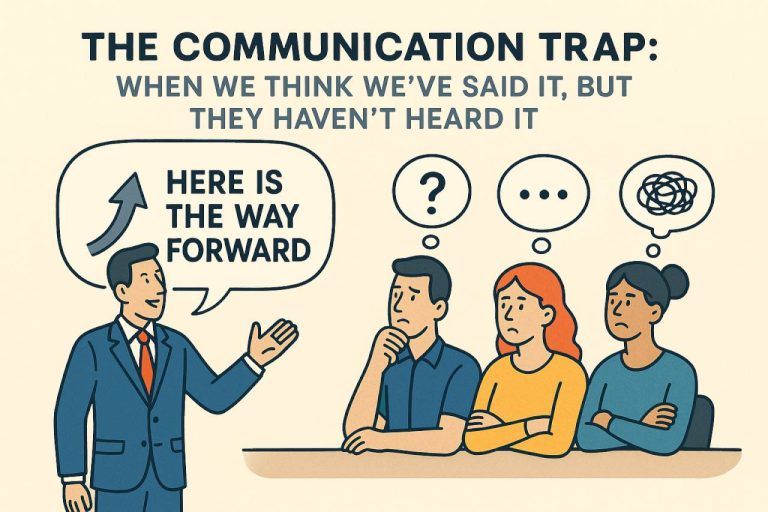One of the most common – and most overlooked – pitfalls in communication is how our brain tricks us. It remembers that we said something, but not necessarily when, to whom, or in what context. We’re convinced the message has been delivered simply because we remember formulating it. But we often forget who actually heard it.
A simple example from everyday life makes this clear: You tell your kids about a new house rule. A month later, you’re sure you’ve communicated it and get frustrated when one of the kids doesn’t follow through. Only then do you realize: the child who “wasn’t paying attention” wasn’t even there – they were in the bathroom when you said it. So yes, you said it. But not to the person who needed to hear it.
This happens all the time in the workplace too. We believe that once something has been said – in a meeting, an email, or in passing – it has been both heard and understood. But we forget that people may have been distracted, absent, or interpreted the message very differently than we intended.
Often, it’s only around the lunch table or coffee machine that we realize what actually happened. One colleague thought it applied next month. Another didn’t catch it at all. And a third has already interpreted the message in their own unique way.
The Psychology Behind the Communication Trap
- The Illusion of Transparency
We tend to assume that what we know is also obvious to others. When we communicate, we often believe people understand us the same way we understand ourselves. This is called the illusion of transparency – the psychological tendency to overestimate how well others grasp our thoughts and intentions.
This often leads us to skip explanations or context we find “obvious”. The result? Gaps in understanding. People are left confused or misinformed, not even realizing what they’re missing.
A typical example: A manager has been working closely with the leadership team on a new strategy. When it’s time to present it to the rest of the organization, he summarizes everything in a single slide, calling it “the right way forward.” But employees, who haven’t been part of the process, lack the background. They don’t know why the change is happening, what it means, or how it affects them. What seems clear to the speaker is vague to the audience.
- Anchoring
Another principle that reinforces the communication trap is anchoring. This refers to the human tendency to rely heavily on the first piece of information we receive when making judgments.
In a change process, this can be especially tricky.
Imagine a middle manager opens a meeting by saying, “This isn’t a big change.” Even if major updates follow – new roles, locations, responsibilities – many will still interpret everything through that initial anchor. They feel a disconnect between the message and reality, and the message may lose credibility as a result.
- Confirmation Bias
Confirmation bias is the tendency to notice and focus on information that supports what we already believe – and ignore or downplay what doesn’t. This impacts not just how we interpret information, but also how we communicate it.
Take a leader sharing results after a tough quarter. She highlights the positives and says, “We’re on the right track.” But she omits uncertainty about the next quarter, internal disagreements, or critical customer feedback that may signal needed changes. She believes she’s protecting morale. But employees sense something is being withheld – and start to speculate. This erodes trust, even if the intent was good.
How to Avoid the Communication Trap
Being aware of these psychological mechanisms is the first step. Here are some practical ways to improve how your message is received:
- Be Explicit and Thorough
Don’t assume others share your understanding. Take time to explain context, background, and reasoning. Break complex topics into smaller parts and communicate them clearly.
- Confirm Understanding
After sharing a message, check if people truly understood it. Ask clarifying questions and invite feedback. Be open to the possibility of misinterpretation – and address it.
- Encourage Feedback
Create a culture where people feel safe asking questions and admitting when they don’t fully understand. This reduces the risk of messages getting distorted or lost along the way.
- Use Multiple Channels
Don’t rely on a single email or meeting. Combine verbal, written, and visual communication to reinforce your message. Repetition, across formats, increases both reach and clarity.
Final Thoughts
The communication trap is a subtle but powerful phenomenon – especially in fast-paced environments or during periods of change. When we’re not mindful of how information is received, we create a gap between what’s said and what’s understood.
By recognizing concepts like the illusion of transparency, anchoring, and confirmation bias, we can sharpen our communication and become more aware of how people process information differently. It’s not about saying more – it’s about saying it better. And more importantly, about creating space for dialogue and clarification, so the message isn’t just heard – it’s understood.
I’ve seen this trap in action many times – especially when information is shared in fragments. Some people are part of the entire journey and see the big picture. Others only hear bits and pieces in a meeting, missing the “why” behind the decision. This is especially crucial for middle managers, who often act as both recipients and transmitters of information. They must assess how much detail is enough – and who still needs context.
Many organizations invest heavily in external marketing – but forget about internal communication. We overlook that employees are also an audience. They need to understand, believe in, and own the message before it can have real power externally. Internal communication is just as strategic – building understanding, engagement, and alignment.
Clarity and context are essential for trust, understanding, and collaboration. Avoiding the communication trap is not just about repeating your message. It requires curiosity about how it actually lands – and the willingness to adjust if it doesn’t.
A simple but underrated way to support better understanding? Good meeting summaries. Not as bureaucratic paperwork, but as living tools that provide insight into the process behind the decision. They help people catch up, revisit context, and understand the reasoning – even if they weren’t in the room.
Curious to learn more? Read my article on the value of meeting summaries or explore how technology can help capture key decisions and context more effectively.





